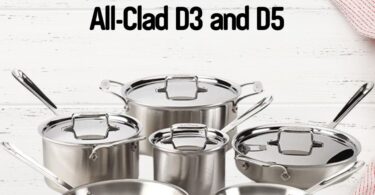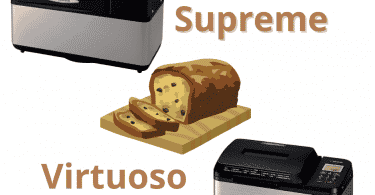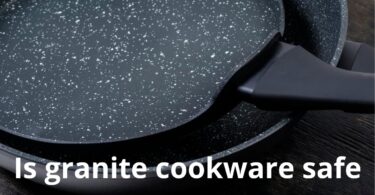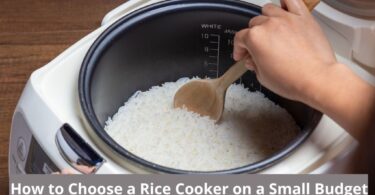Table of Contents
Why is a rice cooker cup smaller than a regular cup? How big is it? Can we use a different cup, or is using this exact one critical for the quality of the final product? All these questions are absolutely legit, and we’re going to answer all of them. Join us in our research. You may find some answers unexpected and amusing.

How big is a rice cooker cup?
Your eyes are not deceiving you. A rice cooker cup is smaller than a regular measuring cup. And the rice cooker size doesn’t matter. To be precise, a rice cooker cup is 3/4 the size of a regular cup. How much rice goes there? That is 180 ml, which is a standard portion size for 1 person. Logical and convenient, isn’t it?
A standard measuring cup used in western cooking is 240 ml.
Why is a rice cooker cup smaller?
To answer this question, we are going almost 200 years back to Japan at the end of the 19th century. Then, an official measurement unit called gō was approved. The word gō means ‘cup’, and that measure was used to determine the amount of rice. Why? Because gō contains a perfect amount of rice for one person.

Time has passed, and gō is not used as a measuring unit anymore. Nevertheless, in rice cookers, measuring cups preserved their historically contingent volume.
But how come all rice cookers have the same size of cups? The answer lies in history, too. The first rice cookers were produced in Japan by a well-known company, Toshiba. They started this tradition, which was then continued by other manufacturers.
While doing our research, we got curious: why do we use a measuring cup in a rice cooker in the first place? Measuring by volume and not by weight is not as accurate, and it would be more logical just to use the scales…
But don’t underestimate the people for whom rice is a deeply embedded cultural concept — the essence of a culture. Their choice of measurement is not random.
There are more than a hundred varieties of rice in the world, and they don’t weigh the same. But you need to be precise to prepare perfect rice. The weight depends on the grain type and the moisture content.
A measuring cup of jasmine rice and a full cup of basmati rice will differ in weight. And that’s not all. The weight of rice from different crops can vary, too (for example, this year’s rice batch compared to the previous year’s crop). So, the best solution was to use volume-based measurement.
One of the most common types of rice used in Japan is koshihikari. It’s white, polished, has short grains, and is used in pretty much any dish, from sushi to chirashi.
Another one is called uruchimai — plump, short-grain rice with a sticky and solid texture. It has a specific sweet taste. You can find this rice in any Japanese household.
And last, but not least, the discovery we made — when measuring rice with a rice cooker measuring cup, you should fill it to the brim. Then take away the excess with a chopstick (or some other kitchen utensil at hand). This way, you’ll get exactly 1 gō or 180 ml of rice.
How do you measure ingredients with a rice cooker measuring cup?
How about we walk you through the entire process of loading the rice cooker and cooking rice?
It is always useful to follow every step of the cooking process, even if in our case this process is not complex at all.

Measure the rice. 1 rice cup per person is a standard serving size unless you have some super enthusiastic eaters.
Rinse the rice. Rinsing is important, as the excess starch will wash away, and cooked rice won’t get sticky. If you go for a fluffy texture, don’t forget this part.
Add the water. Pour the water up to the line in the rice cooker bowl. The lines are intended for white rice. If you cook brown rice or red rice, follow the instructions from the rice cooker manual.
Start cooking. Set the mode on your rice cooker according to the manual.
Let it rest. Cooked rice needs 15 minutes of rest. The lid on the rice cooker should be closed so that the steaming process continues. This way the rice won’t stick to the bottom of the rice cooker.
Fluff it. Now you have a perfect light and fluffy texture.

What can you do without a rice cooker cup?
Let’s speculate a little. Imagine that your rice cooker measuring cup is lost, stolen, broken… The point is, it’s unavailable. How can you do without it?
The main thing you should remember if you don’t have a rice measuring cup is the water/rice ratio. Take 1 cup of water for every cup of uncooked rice.

As we don’t have a rice cooker measuring cup, use any measuring cup like an American measuring cup. Just don’t forget that it’s bigger.
This ratio works only with white rice.
If you cook brown rice, the water/rice ratio will be different: 2 cups of water for 1 cup of brown rice.
Actually, we picked one more measuring method without rice measuring cups. It’s pretty smart. We called it a ‘knuckle method’. Put the tip of your index finger on the bottom of the rice cooker pot, and fill the bowl with rice, keeping your index finger on the bottom until the rice reaches the top knuckle.
Rinse the rice following the process described before, then fill the pot with water until the water reaches the middle knuckle.
With this method, the measurements won’t be precise, but the ratio will be maintained.
You can use it to cook white rice in a rice cooker when a rice cooker measuring cup is unavailable.
To recap
We hope you found our little research useful and entertaining. Now you know that you are using a rice cooker measuring cup the size of a traditional Japanese measuring unit gō.

By the way, this unit can measure not only one portion of rice but also one portion of sake — another huge part of Japanese culture. Isn’t it symbolic to have one measuring unit for both of them? In a modern premium rice cooker, we use the same cup that Japanese cooks used hundreds of years ago.
You have also found out that although a rice cooker measuring cup is important for achieving rice cooking perfection, it’s not vital. In an emergency situation, you can do without a rice measuring cup. Measuring rice can be even done with your bare hands.

So, we tried to equip you with useful information and provide a little entertainment at the same time. Hopefully, you’ve had fun. Wonder can you fix undercooked rice, read
Frequently asked questions
How many cups is a rice cooker cup?
A rice measuring cup used in rice cookers is actually smaller than a standard cup, precisely 3/4 of an American measuring cup. Measuring cups in most rice cookers are 180 ml, whereas a regular cup is 240 ml.
This size of the measuring cup is attributed to an old Japanese measuring unit, gō. It was used in Japan to determine a single serving of rice and some other products, including sake, by the way.
Rice is usually measured in terms of volume because the weight of different types of rice will vary. For example, the weight of a rice cup of basmati rice and jasmine rice will be different.
What is the cup size in a rice cooker?
Rice cooker measuring cups in most rice cookers can accommodate 180 ml of dry rice. An important detail is that when you measure rice, you fill the cup to the brim, then you remove the excess with a chopstick or some other utensil. This full measuring cup will equal 1 portion of rice. When you cook it, use equal amounts of water and white rice. If you cook brown rice, you’ll need 2 cups of water for 1 cup of rice.
How big is the scoop that comes with a rice cooker?
Rice cooker measuring cups coming with rice cookers are 180 ml in volume. That’s less than a regular cup, which is 240 ml. According to Japanese tradition (and the first rice cookers produced in Japan), 1 cup contains the right rice volume to serve one person.
How do you measure 1 cup of rice?
There are special size cups in the rice cookers. A full measuring cup contains 180 ml of dry rice. It’s less than a standard cup, which is 240 ml. The cup accommodates the traditional amount of rice for a single serving portion.








Leave a Comment